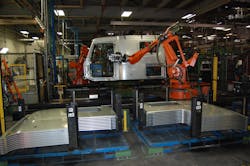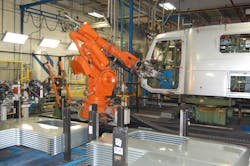The whole idea of developing machines that can think is incredibly unnerving to me; perhaps unsurprising, since The Terminator remains a favorite film from my high school years.
Of course, that’s perhaps an overly Luddite view of the technological capabilities currently being developed – especially where trucking and supply chain management is concerned.
Take recent advances in automated mechanical transmission (AMT) technologies, such as the “I-See” capability Volvo Trucks North America (VTNA) is now incorporating into its I-Shift AMT here in the U.S.; technology introduced in Europe about four years ago.
Wade Long, VTNA’s director of product marketing, recently told me that “I-See” basically gives “eyes” to the I-Shift transmission, so it can “see” and more importantly learn about the road ahead, storing that information for future use.
This, then, is but one of the roles “thinking machines” are being designed to play in the transportation world – a theme data scientist Will Hickie touched on this space last week (though he hates the term “data scientist.”)
Of course, thinking machines are expected to perform duties far beyond merely helping transmissions adapt better to road conditions and thus save on fuel.
In a recent survey of 521 information technology (IT) professionals worldwide conducted by analytics firm Freeform Dynamics on behalf of IT software company Ipswitch, investment in intelligent business systems and automation is “well underway across the globe.”
Some of the biggest “deployment areas” for intelligent machines are: digital customer engagement systems (55%), process automation and workflow systems (52%) and automated risk monitoring and management solutions (50%).
Some of the other developments where “thinking systems” are concerned, according to this poll at least, include:
- 45% have adopted intelligent IoT (Internet of Things) platforms and services, with 34 % saying these technologies are on the agenda.
- 42% are utilizing autonomous apps and “bots,” with another 32% say they plan to do so.
- 45% are using cognitive computing and inference engines and a further 30% are looking to deploy in the near future.
- 40% are using complex event processing (CEP) technology and a further 34% plan to soon.
To give just one example, a fifth of respondents (20%) said increased “noise” on today’s global computer networks network is making it harder to detect malicious activity, with automated/bot access creating unexpected security exposures for starters.
When questioned further, more than two-thirds (68%) of respondents to Ipswitch’s survey confessed their current network security and access management capabilities were “already inadequate” or needed strengthening to cope with new intelligent machines, while 72% revealed network traffic monitoring and analysis capabilities also required reinforcing.
“Organizations are harnessing the transformative powers of intelligent systems to gain competitive advantage. But IT decision makers recognize that, while a force for good, these technologies also expose the enterprise to new internal and external risk vectors,” noted Tony Lock, one of Freeform’s senior analysts, in the survey. “As the pace of adoption increases, there will be no escaping the impact of intelligent systems on the enterprise – regardless of whether or not organizations directly invest in such technologies.”
He added that a further 72% of respondents said the same applied to their file and document level security and access management systems and protocols. Looking to the future, the survey revealed IT professionals were also concerned about how to counter the potential impact of intelligent systems activity – including external third party bots, agents and internet-connected “things” – on enterprise networks and infrastructures.
This is worrisome as the pace of “thinking machine” adoption is usage is only expected to increase:
- A quarter of those polled in the Ipswitch survey expect fully autonomous self-learning robots to be functioning independently within a business setting in less than three years, with a further third saying this will happen within 10 years.
- Rogue decision-making resulting in direct commercial damage and an over reliance on machines, ultimately leading to complacency were cited as current or future concerns that need addressing
- One fifth of respondents confirm a lack of human oversight and de-skilling, to the point where no one in the IT team understands the logic or processes underpinning systems, is a problem today.
- Some 76% of those polled believe these solutions will remove drudgery from IT operations, while just 32% are concerned intelligent systems may eventually put them out of a job.
“IT professionals should approach intelligent machines with their eyes wide open,” stressed Jeff Loeb, chief marketing officer at Ipswitch, in the survey.
“As network managers grow more confident with intelligent systems, they will become increasingly willing to tackle more complex applications,” he added. “However, they need to ensure they have the right tools in place to enable intelligent systems and support the IT team to manage the impact of internal and external intelligent automation effectively.”
That includes ensuring such self-thinking systems don’t end leaving human beings exposed to greater harm on our roadways, as well.
And, hopefully, we’ll never have to worry about any of Stephen King’s fever dreams regarding malicious machinery coming to life, either.

